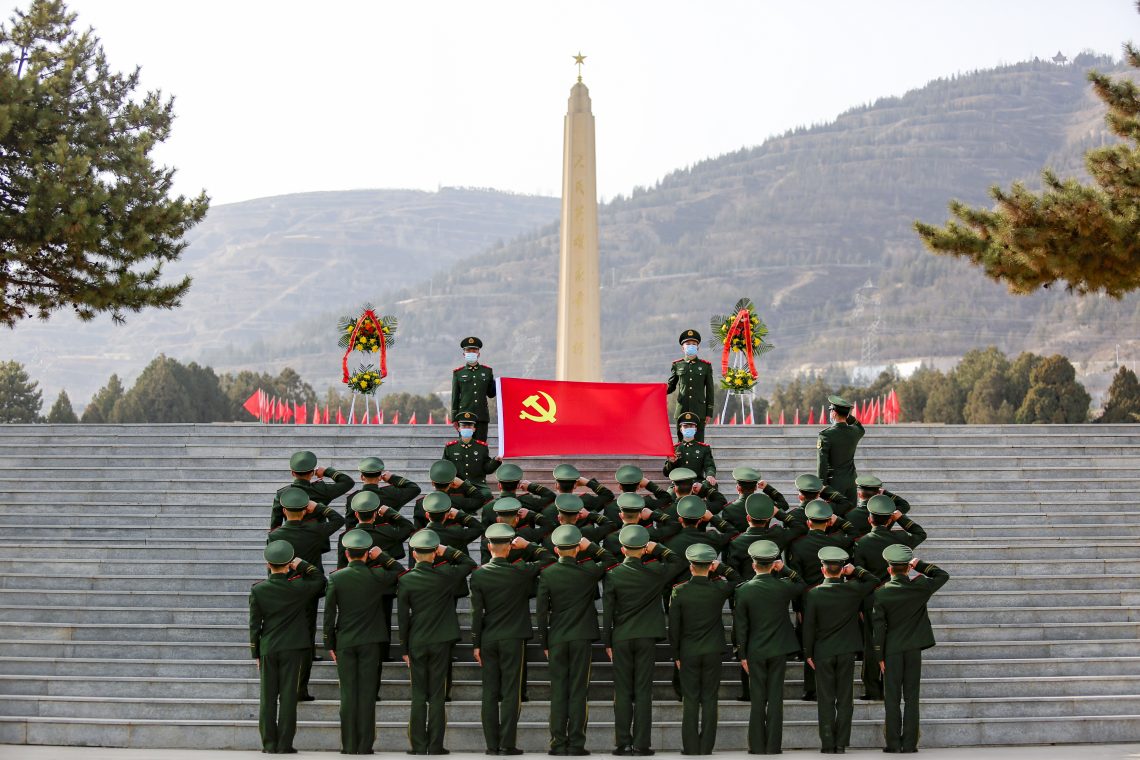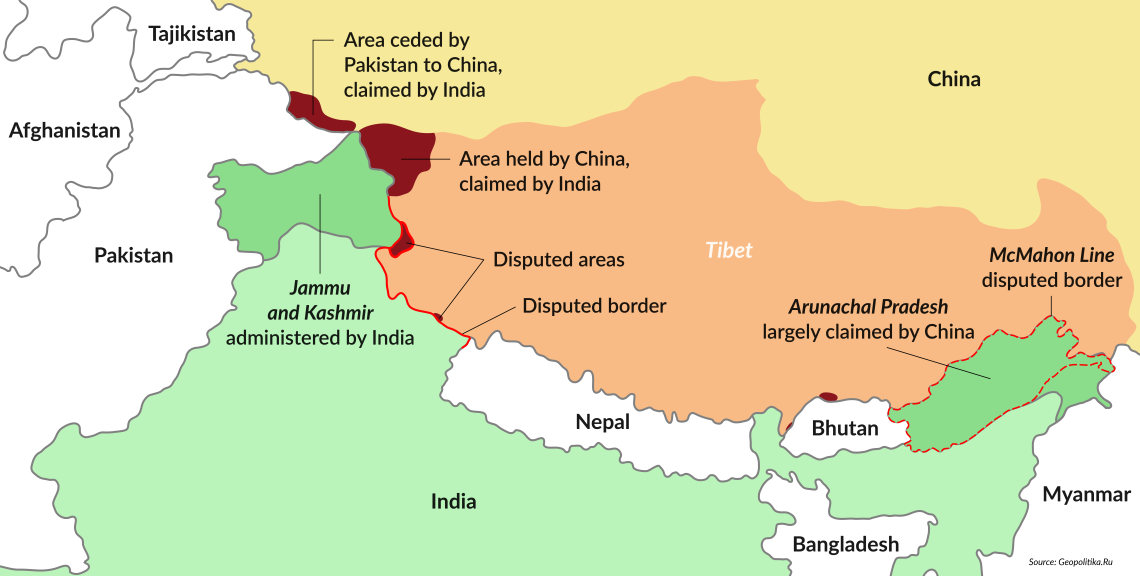Rising tensions along the Indian-Chinese border
India and China are engaged in an infrastructure-building competition along disputed border areas, raising the risk of escalation between the nuclear-armed powers.

In a nutshell
- The Sino-Indian border remains tense after clashes in 2022
- Both sides militarize and build infrastructure, increasing risks
- The world’s two largest nations have found no agreement
Since December 2022, when Chinese and Indian troops again clashed along their 2,100-mile-long contested border – also known as the Line of Actual Control (LAC) – both sides have further militarized with little sign of abatement. Earlier clashes, including the June 2020 Galwan Valley melee in which at least 20 Indian and four Chinese soldiers were killed, prompted the most perilous Sino-Indian border crisis since 1967.
India and China are now locked in a frenzied infrastructure-building competition. The buildup suggests both sides have strategically decided to leverage peacetime to bolster their logistical capabilities for a potential war. This already delicate situation further risks being compounded by their more assertive foreign policies and red herrings, including Sino-Pakistan relations and tensions around the Dalai Lama’s succession. The potential for escalation between the two nuclear-armed powers remains high.
China’s border buildup
The LAC is generally divided into three sections. The western section comprises Ladakh on the Indian side and Tibet and Xinjiang on the Chinese side. The middle section runs along the Indian states of Uttarakhand and Himachal Pradesh and, on the Chinese side, Tibet. Finally, the eastern part comprises Arunachal Pradesh – what China calls “South Tibet” – and Tibet. The first and last sections are the most contested, and where militarization efforts have been concentrated.
In the western section, in Tibet, satellite images point to an increasingly established Chinese presence. There the Chinese Communist Party (CCP) has since 2017 ordered the construction of an extensive network of military installations to support the deployment of People’s Liberation Army (PLA) troops. “Well-off villages” – xiaokang – have been erected to resettle more than 250,000 Tibetans closer to the border to add permanence and credibility to Beijing’s territorial claims. The villages include dual-use infrastructure such as housing, roads, public service facilities – including supermarkets, schools and police stations – as well as internet or 5G connectivity.

The villages form part of the CCP’s broader “Plan for the Construction of Well-off Villages in the Border Areas of the Tibet Autonomous Region,” which involves the construction of 628 villages in 112 Tibetan border towns. As of last year, the construction work of all villages has been completed. While the exact locations of the settlements are not publicly known, India’s Foreign Ministry has suggested that one village in Arunachal Pradesh, in the LAC’s eastern section, lies 4.5 kilometers within India’s claimed territory.
The villages enable Beijing to assert territorial control, a reflection of the CCP’s civilian-military fusion policy. Tibetan herders are deployed alongside PLA and CCP security units as plainclothes security operatives. Together they form “border patrol teams” responsible for conducting monthly patrols. The patrols – held multiple times a month and lasting from three to 10 days – are intended to instruct PLA and CCP units on local conditions and routes. Chinese flags are also placed “at key spots when necessary to claim the territory,” reported China’s Global Times. Ongoing PLA recruitment drives in the villages further ensure a reserve of security personnel.
China’s growing presence near the LAC includes air bases, heliports and air defense sites. All have more than doubled in number since 2017. In the LAC’s western section, China has also invested in constructing a major highway, G695, that will connect Tibet and Xinjiang. Due to be completed by 2035, the route lies approximately 20-50 kilometers from the LAC. It will span the entirety of the disputed Aksai Chin region, through the Galwan Valley to Pangong Tso Lake, where the CCP has been laying the foundations for a significant and long-term military presence.
Satellite imagery from October 2022 shows what appear to be new PLA headquarters and garrison flanked by trenches and revetments for storing and securing equipment and shelters for weapons. A new radome – most likely for signal intelligence collection or radar – is under construction on a mountain peak north of the lake. Just 23 kilometers away, China is rushing to complete a bridge across the Pangong Tso that will connect the north bank – in what India claims as its Ladakh region – with the south bank in Tibet. The bridge could facilitate the movement of PLA troops and equipment. It is also a means by which China is creating facts on the ground to advance its territorial ambitions.
Facts & figures
Disputed Indian-Chinese border areas

India’s infrastructure response
The buildup is a two-sided affair. Since 2020, India has also accelerated its construction of dual-use connectivity infrastructure along the LAC. In the eastern sector, it is building the Arunachal Frontier Highway, a 2,000-kilometer road that follows the McMahon Line. The highway will begin at Mago in Arunachal Pradesh, adjacent to Bhutan. It will pass through Tawang and end at Vijayanagar near Myanmar. Located 20 kilometers from the LAC and set for completion by 2027, the road will facilitate the movement of Indian Army troops and equipment between valleys – a task now complicated by rugged terrain and harsh climate.
Also under construction in Arunachal Pradesh are the East-West Corridor highway, the Trans-Arunachal Highway – which will run the entire state length – and dozens of smaller roads, bridges, tunnels, air bases and heliports. Once completed, the 12-kilometer-long Sela Tunnel will provide strategic all-weather connectivity to Tawang, near the LAC. Critically for the Indian Army, it will help to conceal its regional movements now visible to the PLA from the Sela Pass, 4,000 meters above sea level.
In April, the Indian government launched a $600 million “Vibrant Villages Program” to develop 2,967 villages along the LAC. The program, which in some respects mirrors the CCP’s “well-off villages” initiative, includes the construction of roads, public services – including water supply, electricity and internet connectivity – and healthcare centers. During the first phase, from 2023-2026, 662 villages are due to be built. Not yet apparent is whether the program aspires to the kind of civilian-military integration embraced by its Chinese counterpart. So far, it appears to be kept distinct from military activity along the border. Yet comments made by Indian Army personnel suggest this could yet change. Indeed, India’s accelerated infrastructure buildup suggests a more assertive long-term posture.
Rebalancing the Indian Army
The Indian buildup reflects New Delhi’s recognition of the altered strategic reality along the Sino-Indian border. Following the 2020 clashes, Shivshankar Menon, former Indian ambassador to China and national security advisor, noted, “political relations will now be more adversarial, antagonistic … there is no grand bargain.” For India, the 2020 crisis and CCP activities after that have amounted to a rupture in the entire bilateral relationship.
In addition to new border-management architecture, India’s recognition of this more general threat has prompted a rebalancing of its military forces away from Pakistan to the LAC. In 2021, the Indian Army reoriented its I Corps – one of its three strike corps – into a mountain strike formation responsible for launching offensive strikes across the LAC from Ladakh. I Corps had previously been tasked with penetrating Pakistani territory in wartime. Such a conversion into mountain infantry requires extensive retraining and reequipping. It suggests that India’s military shifts are likely not a short-term surge but a permanent reassignment of its forces.
India’s 17 Mountain Strike Corps (MSC) – until 2021, the only strike corps dedicated to offensive operations against China in wartime along the LAC’s western and eastern sectors – has also received 10,000 additional troops and equipment. It has also been reoriented to concentrate exclusively on the LAC’s eastern sector, with I Corps now focused on Ladakh in the west. Since 2022, 17 MSC is also among the Indian forces participating in the Army’s Integrated Battle Group trials – an effort to convert the Indian Army into more flexible and agile units buttressed by advanced technological capabilities.
Several other formations have also been directed to concentrate on the LAC, including along the middle section in Uttarakhand. As of 2021, more than 50,000 Indian troops are stationed along the LAC, with border stability an Indian prerequisite for any normalization of ties with China.
CCP salami strategies
In January, Indian officials claimed the PLA had increased its troop presence along the LAC’s eastern sector near Arunachal Pradesh. Though updated figures are not publicly available, as of July 2020, the PLA had more than 200,000 soldiers deployed to its Western Theater Command (WTC), which oversees the entire Sino-Indian border region, including Arunachal Pradesh. The addition of troops to an already ponderously large military presence – also given CCP concerns over the American forces in the Indo-Pacific – suggests the CCP’s increased prioritization of the WTC and the LAC.
The PLA’s strategy along the LAC is akin to that deployed in the South China Sea, where China uses a combination of hybrid and salami-slicing tactics. Along the LAC, for example, Chinese forces have patrolled up to their claimed LAC while the Indian army has generally remained short of the LAC, approaching only a line of 65 patrolling points (PPs) a few kilometers from the understood border.

The PLA seems to have taken advantage of this unpatrolled gap to shift the LAC back to the PPs line in India’s territory. As of January, India had lost access to 26 of its 65 PPs. That means India has de facto ceded territory under its control to China.
On April 1, China’s Ministry of Civil Affairs released an updated list of “standardized geographical names” for 11 places in Arunachal Pradesh. The list contains the names in Chinese and Tibetan characters, and in pinyin, in what the CCP’s Global Times newspaper called “a legitimate move and China’s sovereign right.” Arunachal Pradesh – “South Tibet” for the CCP – “has been China’s territory since ancient times,” the missive continued. That is not the first time China has tried to advance its territorial claims by renaming localities. Similar lists concerning Arunachal Pradesh were issued in 2017 and 2021, just days before the CCP’s Land Borders Law came into effect.
The 2021 law authorizes Chinese forces stationed along the border to use weapons to stop “illegal” border crossings. China can also close its borders in “situations that seriously affect the security and stability of the land border and border areas.” The law prohibits building permanent facilities “near” China’s border without Beijing’s permission. The vague language could be interpreted to include both sides of the LAC, which could create further friction as India pushes to construct infrastructure and villages. Under international law, effective territorial control is the sine qua non of a territorial claim. Armed patrols do not prove such control, but permanent settlements do.
Scenarios
Diplomatic efforts between India and China – including the most recent May meeting of a joint working group on border issues – have not amounted to much. Yet this is no surprise. While the continued diplomatic exchange is welcomed, it obfuscates the reality of a rapidly militarizing LAC by both India and China. As a matter of policy, New Delhi has placed the border dispute at the center of Sino-Indian relations. Unless the two sides agree to a new modus vivendi, competition will persist unabated.
The CCP will also likely continue to develop new military capabilities within operational reach of the LAC and advance its salami tactics – as it did after the 2020 clashes and its policies for national rejuvenation prescribe. Military and infrastructure developments along both sides of the LAC are also likely to spur further investments – and with more troops on both sides in relatively closer contact, the risk of destabilizing disruptions has increased. The most likely scenario is continued escalation with enhanced potential for conflict.
Other points of friction between India and China compound this already complex scenario. Possible naval standoffs in the South China Sea, developments in Tibet related to the Dalai Lama’s succession, economic sanctions, the CCP’s strategic embrace of Pakistan, as well as cyberattacks - like those recently launched by Chinese hackers on India’s electrical grid - would all place added pressure on Beijing and New Delhi. It is, however, difficult to foresee whether either would then opt to escalate or de-escalate.
A less likely scenario would suggest the latter, as well as a large-scale disengagement from the LAC. For instance, in the event of renewed violence, Beijing and New Delhi could finally be pushed to delineate and demarcate the LAC. Such a settlement would be worthy of Indian and Chinese policymakers’ efforts, as it would unshackle their militaries and allow for strategic reorientation elsewhere. Yet the CCP’s emphasis on sovereignty and growing Indian assertiveness make this unlikely. The long shadow of history is likely to persist, with ample possibility for future war.








